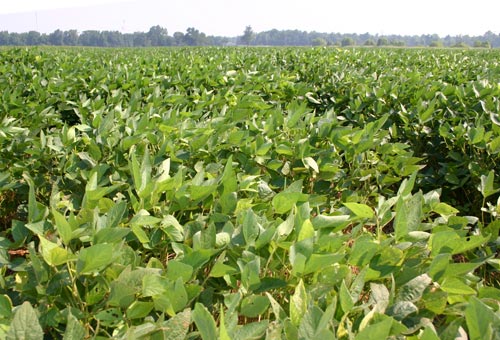April 6, 2011

Louisiana farmers are battling a fungus that’s been around for decades but has recently become the No. 1 disease problem for Louisiana soybeans, the No. 1 row crop in the state, according to LSU AgCenter experts.
LSU AgCenter plant pathologists estimate cercospora leaf blight can reduce soybean yields by 10 to 15 percent.
In 2010, Louisiana farmers planted more than 1 million acres of soybeans with a farm-gate value of $424.3 million, according to the LSU AgCenter Ag Summary.
The foliar disease can remain latent in growing soybean plants for several weeks before they show symptoms, according to LSU AgCenter plant pathologist Boyd Padgett.
 The disease has become a problem in Louisiana only in the past five to 10 years, said Zhi-Yuan Chen, an LSU AgCenter researcher. In effect, it’s a relatively new disease with a lot of questions still unanswered.
The disease has become a problem in Louisiana only in the past five to 10 years, said Zhi-Yuan Chen, an LSU AgCenter researcher. In effect, it’s a relatively new disease with a lot of questions still unanswered.
Many species of cercospora fungus exist, and most are problems with only one type of plant. The strain that attacks soybeans has been around for about 60 years in the United States and has worsened over time, Chen said.
The fungus survives in infected seeds and plant residue and forms spores on the residue surface during warm, humid weather, experts say. The spores are wind-blown or rain-splashed to new soybean tissue where infection occurs. Seeds also can carry the fungus.
The fungus discolors the leaves and stops or impairs photosynthesis, Chen said. It can be found in seeds and on plant debris, and healthy-looking plants can harbor it.
The visual effects generally start at the top of the plant canopy, hindering photosynthesis. This slows pod and seed growth and results in reduced yields, Chen said. In addition to leaf blight, the fungus also causes purple seed stain.
Although the disease appears late in the season, the infection starts long before symptoms appear, the plant pathologists say. It goes through an incubation or latent period.
“You don’t see it, but it’s there,” said LSU AgCenter plant pathologist Ray Schneider. “Once you see it, the damage is done. That’s why it’s become difficult to control.”
One thing AgCenter researchers have discovered, however, is that very early applications of fungicides, long before symptoms develop, provide a surprising level of disease control.
“Our research suggests that fungicide applications as early as first flower plus an additional application later in the season may be required for optimum disease management,” Schneider said.
“It is important to apply these fungicides during the latent infection period rather than waiting until the appearance of first symptoms,” Schneider said.
“The practice should be an early application followed by a later application,” Padgett said. “Even with two applications, producers are finding this hard to manage.”
Results from an earlier AgCenter study of Asian soybean rust indicate certain soil nutrients may be related to decreased incidence and severity of soybean diseases, Schneider said.
“Analyses are still ongoing, but it appears that certain minor elements, including iron, zinc, boron and copper, affect disease development. We will be attempting to manage cercospora leaf blight by applying these minerals in different concentrations and combinations,” Schneider said.
In addition, Chen and Schneider are creating a procedure to monitor the infection process. They have developed DNA probes that can reliably detect the presence of cercospora pathogens in field-grown soybean plants one to two months before the disease symptoms appear.
This early-detection method allowed Schneider to work out a more effective fungicide treatment to control the leaf blight disease by monitoring the presence of fungal DNA after the treatments.
This work will be expanded during the 2011 growing season when the researchers begin identifying fungicides, application rates and timing, Schneider said. “If our earlier findings are confirmed, we will need to develop recommendations and possibly combine an early fungicide application with an insecticide or herbicide.”
The LSU AgCenter soybean breeding program led by Blair Buckley at the Red River Research Station in Bossier City focuses on screening varieties to look for soybean lines with resistance to cercospora leaf blight. Disease-resistant varieties would reduce the need for fungicides.
Breeding lines are evaluated for disease resistance in each generation, but “lines with complete resistance to the disease have not yet been identified,” Buckley said.
Current lines with the most resistance don’t have any apparent yield loss, decrease in seed quality or premature defoliation, he said. “Disease symptoms in these lines consistently develop at a later stage of growth than in highly susceptible lines.”
Buckley said that a better understanding of when infection occurs and how symptoms develop in moderately resistant lines versus highly susceptible lines will aid the effort to develop disease-resistant soybean varieties.
Contacts:
Boyd Padgett at 318-614-4354 or [email protected]
Zhi-Yuan Chen at 225-578-7850, or [email protected]
Ray Schneider at 225-578-1464, or [email protected]
Blair Buckley at 318-741-74340, or [email protected]
You May Also Like




